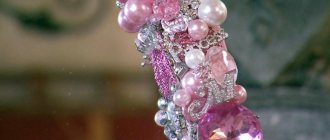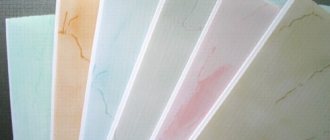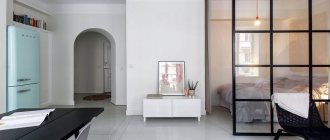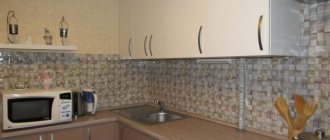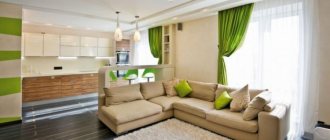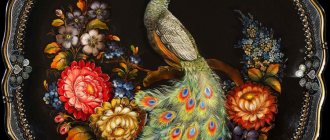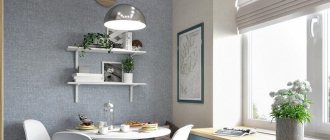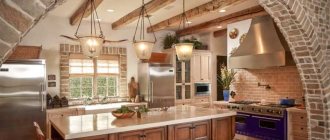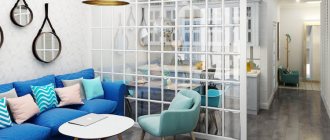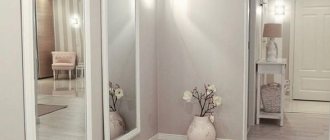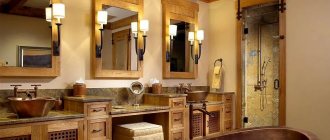In houses built in pre-perestroika times, the toilet and bathroom are often located separately, which has a negative impact on the dimensions of the premises.
The combined bathroom also doesn’t look comfortable. Due to its small size, placing hygiene items is difficult.
Therefore, during renovations, it is worth thinking about making some changes in the location of the shower and closet, fencing them off with special curtains or barriers.
Glass partitions are great for zoning living spaces and as a shower stall. Order the production of a glass shower partition in St. Petersburg from Glasslinegroup.
Purpose of a partition in the bathroom
There are several situations when the use of a partition is justified for owners:
- Decorative function. In such cases, the room is divided into several functional zones. For example, one of the compartments is intended for storing clean linen. The second compartment can be used for a basket with dirty laundry, towels or for drying wet laundry after washing. The main part of the room is occupied by an area with a bath or shower.
- The second most common situation is when there is a bathroom combined with a toilet. This factor creates a particular problem in large families, with children or elderly people. In such cases, the bathroom can be divided into two halves. If desired, you can arrange separate ventilation and lighting for each of the resulting zones.
- The third situation arises when you need to isolate the bath or shower from the rest of the room. In such cases, glass, fabric, plastic curtains or partitions are used. Glass shower screens are most often preferred for bathrooms. These structures can have a hard or soft base, take the form of sliding or folding panels, can be hung on rotary fittings to a pallet, on the floor, or attached to a wall.
Another interesting option for the practical use of partitions is observed in some modern interior styles. In these cases, the bath is located directly in the bedroom.
To visually and hygienically separate the bathing area from the living area, partitions or screens are purchased.
Bulkhead made of plasterboard sheets
GCR is the most versatile of all available materials. It has a number of positive qualities, namely:
- Easy to cut and install. Even a beginner can handle it
- Light weight. There is no need to hire a team of movers to deliver plasterboard sheets to the premises.
- Quick installation of the frame - put a metal profile on the marked sketch - it takes 2-3 hours
- Possibility of using figures of any complexity and any finishing materials in design
But it also has disadvantages - with its dense structure, its thickness is at least 5 cm. Therefore, a bathroom partition made of plasterboard will take up a little more space than one made of glass. In addition, gypsum board is afraid of damp rooms.
Installation of gypsum boards begins with determining the mounting location for the racks in increments of 50 cm, as well as with markings on the ceiling and wall.Important! Due to the fact that the bathroom is a room with high humidity, it is necessary to choose special moisture-resistant drywall.
Guide profiles are fixed according to this sketch. The distance between the fasteners is 100 cm, and between the wall and the edge of the metal - 50 cm.
The length of the stand is 2 cm less than the height of the ceiling. At a height of more than 250 cm, the structure must be strengthened.
Next, one of the sides is sheathed with plasterboard sheets using self-tapping screws. The intermediate space is filled with mineral wool.
Attention! When working with glass wool, you must wear goggles and gloves to avoid injury.
Having filled the inside with filler, the second side is sheathed. The final touch remains: decorating the partition
First, plaster tape is glued to the joint, then covered with putty, and a primer is applied. Further design work is done at the discretion of the owner.
Partition requirements
The production of furniture products does not stand in one place, and the choice of finished goods is quite extensive.
What parameters should you pay attention to when purchasing a partition for a bathroom:
- The material used is of particular importance. The service life of the product, its strength, resistance to moisture and detergents directly depend on this parameter. Today there are a lot of options from which you can make a partition for the bathroom, including with your own hands.
- The design of the screen is a very important selection criterion. Modern screens have different shapes (oval, classic square or rectangle, rhombus, triangle).
- Features of practical care of the septum surface. This criterion depends on the material of manufacture. For example, tempered glass panels should not be cleaned using brushes or abrasives. Such products can leave rough scratches and cracks on the surface.
- Bathroom owners need to choose the type of screen: a movable or stationary model. As a rule, fabric partitions or paper models can be freely moved to another location. Structures made of wood, aluminum, and gypsum are quite heavy and therefore classified as stationary installations. The glass partition requires special attention, unnecessary movements of which can lead to damage to the screen.
Before purchasing such furniture, you should carefully inspect the screen for chips, scratches, cracks, and defects. You should also clarify the quality composition of the product, the presence of rotary fittings (for example, for sliding and hinged partitions).
Self-installation
Do-it-yourself bathroom renovation and design is most often done using structures made of moisture-resistant plasterboard. This is due to the low cost of the material and ease of installation. When assembling a gypsum board wall in the bathroom, you need to think in advance about the arrangement of additional lighting and the location of the built-in shelves. If a partition in the bathroom is needed only for differentiation, communications can be removed inside it, and the rest of the space can be filled with soundproofing material. Mineral wool slabs that do not deform due to their structure are suitable for this purpose.
When calculating the required number of sheets of drywall in a bathroom for a partition, you need to multiply the resulting number by two, because the structure is sheathed on both sides.
Rack profiles are mounted vertically with a distance of 0.6 m between them, and guides are mounted horizontally, on the floor and ceiling.
The stability of the wall depends on the fasteners. The profile is secured to the surface with screws and dowels, and the rack elements are attached to the guides with screws for metal. When sheathing the frame with plasterboard sheets, self-tapping screws with a countersunk head are used.
For external pre-finishing of a plasterboard wall, you will need a primer, moisture-resistant putty, and fiberglass tape to reinforce the seams.
Tools required for installation of a plasterboard partition element:
- hammer drill, concrete drills;
- screwdriver;
- metal scissors;
- gypsum board cutter;
- level;
- two or three spatulas, a brush;
- container for primer and putty.
Having collected everything you need, you can begin assembling the plasterboard wall for the bath with your own hands.
Advantages of wooden partitions
One of the most popular are wooden screens. These structures can be made from either solid wood or chipboard panels. They are distinguished by their special durability and beautiful decor.
As a rule, such partitions are stationary models and are used to divide the bathroom into several functional areas. However, such screens require more careful care, and it is recommended to pre-treat all surfaces with an antifungal compound.
Materials used
To install the screen you will need:
- guide profile (aluminum can withstand heavy loads and will last longer);
- sheets of plastic or glass cut to size;
- silicone sealant;
- accessories: hinges, screws, etc.
Transparent materials are the most popular: they are economical and do not overload the interior. The most expensive option is tempered glass with a decorative pattern.
Plastic or polycarbonate
Plastic attracts with its variety of colors, decor and low price. It is practical, easier to work with at home: it is easy to cut, does not prick, etc. The main disadvantage of this material is that it will not last as long as glass or polycarbonate, it is easily scratched and quickly loses its appearance.
When choosing this material, keep in mind that plaque and dirt appear on it quickly. With insufficient care, the appearance becomes untidy and the surface becomes cloudy. Fungus or mold may appear.
Polycarbonate is a durable, versatile polymer. It is lightweight and impact-resistant, therefore safe and easy to install.
It is more practical in operation than plastic; it can easily withstand high humidity and temperature changes, which is why it is often used for making cabinets and screens. In appearance and durability, things made of polycarbonate are no worse than glass.
Glass
This material is not as impact-resistant as polycarbonate, although high-quality tempered glass comes close in this characteristic. The safest and most durable is triplex. The risk of injury when using it is minimal: if such glass breaks, it will not crumble into small and sharp fragments.
The remaining performance characteristics of this material are higher than those of plastic. Mold does not form on it; its surface can be easily cleaned with a special product and a cloth or paper napkin.
A transparent glass screen is a win-win option, suitable for any style of bath design.
Advantages of glass partitions
The second most frequently used are bathroom partitions made of tempered glass.
Today on the furniture and fittings market you can find models with a wide variety of designs:
- Absolutely transparent and tinted,
- Matte and glossy surface,
- With a pattern or relief pattern.
Decorative spraying is also widely used.
In practical care of glass bathroom partitions there is a minimum of features: you should clean the glass from dirt and plaque only with a soft sponge or rag, completely avoiding hard brushes. Also, despite the sufficient strength, it is better to avoid strong impacts on the surface of the partition.
Brick
Massive structures are mostly made of brick. Concrete pouring is necessary only when it is planned to form a shower room, and can also serve as the basis for glass partitions.
Advantages of brick partitions:
- it is possible to hide communication nodes;
- excellent sound insulation;
- possibility of facing with tiles, decorative stone and other materials.
- installation of heavy shelves is possible.
Disadvantages of brick structures:
- a significant amount of square meters is required;
- lack of quick dismantling of the structure and making changes.
Partition in the form of a rack
Often, you can divide a room into two zones using a shelving unit. The rack can be small or reach ceiling level. The advantage of such furniture is the availability of sufficient storage space.
Hygiene items, towels, gels and shampoos are placed on the shelves. In addition to being especially practical, this type of partition favorably emphasizes the interior style of the bathroom and does not interfere with natural light.
Advantages of soft screens
Soft partitions are made from various types of textiles. The main requirement for the textiles used is moisture resistance.
- A fabric curtain can be used to protect the surrounding area from bath water.
- Paper folding screens on a wooden frame are used to zone a room.
- As a rule, a drawing, photo printing, or embossing is applied to the surface of such a screen.
In the photo of the bathroom partition you can see all the interesting design solutions. Bathroom owners can also apply the original painting themselves, using acrylic paints and their own artistic skills.
Due to their light weight but certain stability, such structures are quite mobile (they can be moved to a new location or simply moved).
